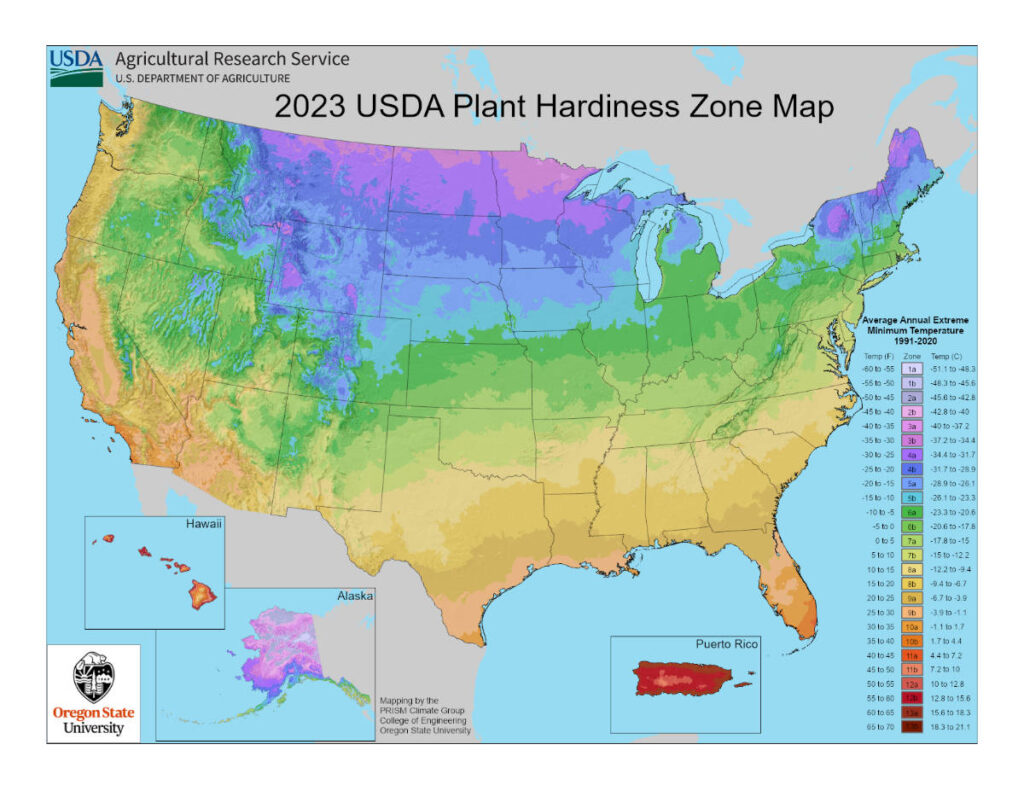The USDA Hardiness Zone Map divides the United States and Canada into zones based on the average annual lowest winter temperature. Considering the local climate, gardeners and horticulturists use these zones to decide which plants will likely grow in their specific region.
Each zone corresponds to a specific temperature range, denoted by a numerical designation. Lower zone numbers indicate colder average minimum winter temperatures in that region, while higher zone numbers indicate warmer winter temperatures.
For example:
- Zone 1: Average annual minimum temperature of -60°F to -50°F (-51.1°C to -45.6°C)
- Zone 2: Average annual minimum temperature of -50°F to -40°F (-45.6°C to -40°C)
- Zone 3: Average annual minimum temperature of -40°F to -30°F (-40°C to -34.4°C)
- And so on

Using the USDA Hardiness Zone Map
Gardeners who know their location’s hardiness zone can choose plants adapted to the local climate. They are more likely to survive and thrive in their gardens or landscapes. This information is especially critical for perennial plants, trees, and shrubs that must resist winter weather year after year.
The USDA Hardiness Zone Map is constantly updated to reflect changes in climate trends, and it is an invaluable resource for plant selection and gardening practices throughout the United States and Canada.
The USDA Hardiness Zone Map is divided into 13 zones, labelled 1 through 13, each reflecting a specific region’s average annual minimum temperature. However, it’s essential to recognize that microclimates, local weather patterns, and other factors may vary within each zone, impacting plant growth and survival.
Hardiness Maps for other countries
Although widely utilized in the United States and Canada, other countries may have their hardiness zone systems or employ different methods of categorizing plant hardiness. These systems often operate on similar principles, assessing plant climate suitability based on temperature data.
Suppose you have specific enquiries about plant hardiness zones in a given location or country. Contact local gardening resources or governmental agriculture agencies for precise, area-specific information.
Other countries outside the United States and Canada have systems for categorizing plant hardiness based on climate conditions. However, the particular zone designations and temperature ranges may differ based on the country and the classification criteria.
For example:
- Europe: The Royal Horticultural Society (RHS) in the United Kingdom developed the RHS Hardiness Rating system, categorizing plants based on their ability to survive cold temperatures. The RHS system uses a scale from H1 to H7, with H1 being the warmest and H7 being the coldest. This system considers minimum winter temperatures, prevailing winds, and rainfall.
- Australia: Various states and regions may have plant hardiness zone systems tailored to local climate conditions. For example, the Australian National Botanic Gardens developed the Australian National Botanic Gardens Plant Hardiness Zone Map, which divides the country into different zones based on temperature data. This map helps gardeners select plants suitable for their specific region.
- New Zealand: New Zealand also has a system for classifying plant hardiness that considers temperature, rainfall, and altitude factors. While there isn’t a standardized nationwide system like the USDA Hardiness Zone Map, regional gardening guides and resources often provide information on suitable plants for different areas.
- Other Countries: Countries worldwide may have their own methods for classifying plant hardiness, depending on their unique climate and environmental conditions. These systems aim to help gardeners and horticulturists select plants well-suited to local growing conditions.
While the specifics of these systems vary, the overall purpose is to provide advice on plant selection based on temperature and environmental considerations to ensure successful gardening and landscaping endeavours.
Examples of USDA Hardiness Zones and their accompanying average annual minimum temperatures
- Zone 1: Average annual minimum temperature of -60°F to -50°F (-51.1°C to -45.6°C). Example: Barrow, Alaska.
- Zone 2: Average annual minimum temperature of -50°F to -40°F (-45.6°C to -40°C). Example: International Falls, Minnesota.
- Zone 3: Average annual minimum temperature of -40°F to -30°F (-40°C to -34.4°C).
- Zone 4: The average annual minimum temperature ranges from -30°F to -20°F (-34.4°C to -28.9°C).
- Zone 5: The average annual minimum temperature ranges from -20°F to -10°F (-28.9°C to -23.3°C).
- Zone 6: The average annual minimum temperature is -10°F to 0°F (-23.3°C to -17.8°C).
- Zone 7: The average annual minimum temperature ranges from 0°F to 10°F (-17.8°C to -12.2°C).
- Zone 8: Average annual minimum temperature of 10°F to 20°F (-12.2°C to -6.7°C).
- Zone 9: The average annual minimum temperature is 20°F to 30°F (-6.7°C to -1.1°C).
- Zone 10: Average annual minimum temperature of 30°F to 40°F (-1.1°C to 4.4°C).
- Zone 11: Average annual minimum temperature of 40°F to 50°F (4.4°C to 10°C).
- Zone 12: Average annual minimum temperature of 50°F to 60°F (10°C to 15.6°C).
- Zone 13: Average annual minimum temperature above 60°F (above 15.6°C).
Gardeners and horticulturists use these zones to select plants appropriate for local climate circumstances, particularly winter hardiness.
Comparing USDA & UK Hardiness
The USDA Hardiness Zone Map and the UK Hardiness Zone system serve similar functions by advising gardeners and horticulturists on the adaptability of plants for various climate situations. However, the two approaches differ in technique and climate factors.
The USDA Hardiness Zone Map splits the United States and Canada into 13 zones according to average annual minimum temperatures. These zones go from Zone 1 (coldest) to Zone 13 (warmest), with each zone indicating a 10°F (5.6°C) variation in average minimum temperature.
On the other hand, the UK Hardiness Zone system needs to be more standardized and frequently uses a separate scale depending on temperature ranges and other climate conditions unique to the UK’s maritime environment. Instead of numerical zones, the UK system frequently uses descriptive classifications such as “Hardy,” “Half-Hardy,” and “Tender,” which reflect a plant’s resistance to cold temperatures and other environmental factors.
While there is no direct correlation between USDA zones and UK hardiness zones due to climate and technique differences, broad similarities can be made based on temperature ranges and growing circumstances. USDA Zone 8 (average annual minimum temperature of 10°F to 20°F or -12.2°C to -6.7°C) is similar to the UK’s “Hardy” category, signifying plants that can tolerate mild to moderate frost and cold temperatures.
USDA Zone 10 (average annual minimum temperature of 30°F to 40°F or -1.1°C to 4.4°C) may be similar to the UK’s “Half-Hardy” category, which indicates plants that may require protection from frost or cold temperatures.
It is critical to understand that while these comparisons might provide some broad assistance, local microclimates, soil conditions, and other environmental factors can all influence plant hardiness and appropriateness in both systems. Gardeners in the United Kingdom should seek advice from local gardening resources, botanical gardens, or horticultural societies on plant selection and maintenance appropriate for their climate.
RHS Hardiness
The RHS hardiness classification employs a scale ranging from H1 to H7, with H1 being the hottest and H7 the coldest. How does this relate to the USDA hardiness zones? Provide an example for all zones.
The Royal Horticultural Society (RHS) hardiness rating system, which employs a scale of H1 to H7, is unique to the United Kingdom and is based on a plant’s typical minimum winter temperature tolerance. Here’s a general comparison between the RHS hardiness ratings and the USDA Hardiness Zones:
- RHS H1: The average minimum winter temperature is above 15°C (59°F). This corresponds to USDA Zones 11-13, which have average minimum temperatures above 40°F (4.4°C). Examples include tropical and subtropical plants such as bananas and citrus trees.
- RHS H2: The average minimum winter temperature is between 1 °C and 5°C (34°F and 41°F). This roughly corresponds to USDA Zone 10, which has average minimum temperatures between 30°F and 40°F (-1.1°C to 4.4°C). Examples: Some tender perennials and subtropical plants like bougainvillaea.
- RHS H3: The average minimum winter temperature is between -5°C and 1°C (23°F to 34°F). This corresponds to USDA Zones 9 to 10, which have average minimum temperatures between 20°F and 40°F (-6.7°C to 4.4°C). Examples: Many hardy perennials and some evergreen shrubs.
- RHS H4: The average minimum winter temperature is between -10°C and -5°C (14°F to 23°F). This corresponds to USDA Zones 7 to 9, which have average minimum temperatures between 0°F and 30°F (-17.8°C to -6.7°C). Example: Most garden plants, including many roses and herbaceous perennials, are commonly grown in the UK.
- RHS H5: The average minimum winter temperature is between -15°C and -10°C (5°F to 14°F). This corresponds to USDA Zones 6 to 8, which have average minimum temperatures between -10°F and 20°F (-23.3°C to -6.7°C). Examples: Many trees and shrubs, including popular garden favourites like magnolias and rhododendrons.
- RHS H6: The average minimum winter temperature is between -20°C and -15°C (-4°F to 5°F). This corresponds to USDA Zones 5 to 7, which have average minimum temperatures between -20°F and 10°F (-28.9°C to -12.2°C). Examples: Some hardy trees and shrubs, including many conifers and deciduous trees.
- RHS H7: The average minimum winter temperature is below -20°C (-4°F). This corresponds to USDA Zones 4 to 6, which have average minimum temperatures below -20°F (-28.9°C). Examples: Very hardy plants, including many alpine and Arctic species.
These comparisons provide a fundamental framework for understanding plant hardiness in both the RHS and USDA systems. Still, it is critical to consider additional criteria such as soil type, exposure, and local climate conditions when selecting and cultivating plants.
